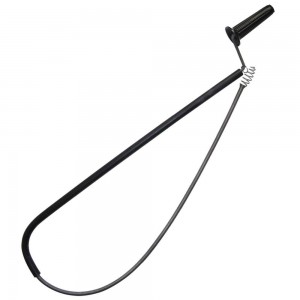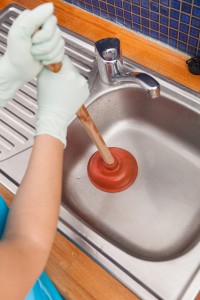A casual Sunday stroll down the cleaning supplies aisle at any local home center looks like an armory chocked full of drain cleaning ordinance. Based on their labels, all these products are terrifically effective, but at the end of the day, once you use these chemicals, they’re gone—literally down the drain.
The best approach to cleaning drain clogs is to never get clogs in the first place. That said, here are a few tips to keep your drains running free:
- Can the grease – Pour used cooking grease into an empty, heat safe container, such as a soup can, and store it in the freezer. Once solidified, toss the can into the garbage.
- Scrape your plate – Scrape all leftover food from pots, pans, dishes, and cooking utensils into the trash can to prevent them from going down the kitchen sink.
- Catch the scraps – Use a sink strainer to catch any food scraps that remain on dirty dishes and plates then toss them into the trash or compost bin.
- Don’t treat your toilet like a trash can – The only things you should be flushing are toilet paper and your “personal” contribution. Anything else, including “flushable” wipes, may contribute to a clog in your home plumbing.
- When a drain starts to slow down, don’t wait for a clog to form. Pour about a ½ cup of baking soda down the drain. Wait a few minutes, then add 1 cup of vinegar, followed by one cup of hot water. Let the chemistry happen for 10 or 15 minutes. Then, run hot tap water down the drain to clean out the congestion, the baking soda and the vinegar.
It’s always best to be proactive about pipe blockages. But when a clog hits your home plumbing, here’s what do to get things flowing again without the use of toxic chemicals. Use these tips to help keep all of the plumbing in your home clear of clogs.
Plunging
Plungers work by forcing air and water toward a blockage. After several good plunges up and down, the blockage will break up, and then can be flushed down the drain with hot water from the faucet. For this technique to succeed, any vent holes must be plugged with a damp rag to prevent air from entering the drain and reducing the suction created by the plunging action. In a sink basin, these are usually inside the bowl under the front rim. In a tub, they’re at the bottom of the overflow plate. If you have a double-bowl kitchen sink, you should plug one of the two drain openings.
But don’t just grab the first plunger you see. A double cup (or an extension cup) model is best because it allows plunging of toilet bowls in addition to sink and bathtub drains.
Augering

A toilet auger, sometimes called a closet auger is designed to remove blocks from toilet traps. A cable is fed into the hole and turned with the handle until the blockage is broken up. A coiled wire bulb at the end of the cable has a sharp point for grabbing solid clogs.
If you’re lucky, a plunger will handle all your slow and blocked drains. But if a bigger clog is afoot, then you’ll need more fire power: either a toilet auger if the problem is with the toilet or a power auger if the problem is in a sink or tub drain.
The toilet auger is a clever cable device made with a coiled wire bulb on one end and a hand crank on the other. This cable rides inside a housing that has a steep bend on one end, designed to fit easily into the hole at the bottom of the bowl.
To use it, insert the bulb end into the hole and keep sliding the cable down until it is blocked. Gently turn the handle to loosen the blockage or to clear the bulb from any built-in obstructions like the joints where pipes meet. If you hit the blockage, just pull the cable back and forth until it breaks up, then wash it down the drain with a fresh flush. If the bulb was stopped by a pipe obstruction, jiggle the cable back and forth until you can push it farther into the drain and on its way to the real blockage.

The power drum auger holds about 20 ft. of coiled cable inside its housing. The cable is pulled out the front barrel until the wire bulb on the end hits a blockage. Then the cable is locked with a lever (seen just above the bulb) and the cable is turned, either by hand or by attaching a drill to the nub provided on the back of the tool.
The power drum auger is made with the same type of cable found in the toilet auger and it has the same coiled bulb on one end and a turning handle on the other. The cable is longer, usually around 20 feet, and comes wound in a metal or plastic housing.
As before, you start by feeding the coiled bulb into the drain opening on the sink or tub and then turning the handle whenever an obstruction is hit. For especially difficult clogs, this auger is outfitted with an adapter for attaching an electric drill. Attach the drill and hand-cranking becomes a thing of the past. Keep in mind that both the toilet auger and the power drum auger are common rental items. If you won’t use them often and don’t want to buy them, then consider renting.
Guest blog submitted by Steve Willson who joined Popular Mechanics magazine as their Home Improvement Editor, authored three books and has edited or rewritten 11 books on various home improvement and tool use topics and now writes for the Home Depot.
